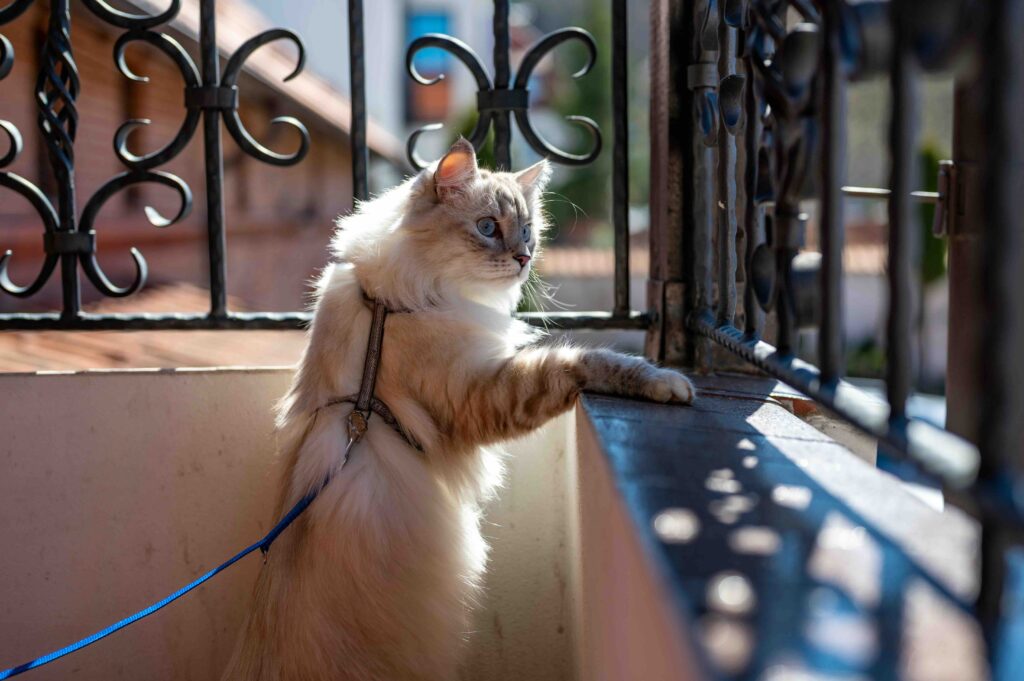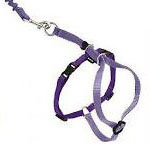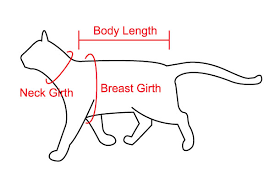


The first thing to realize about a cat harness is that there are none that your cat can’t escape if he really wants to. Even the vest-type of harness, which is the most fool-proof, is not fool-proof. A determined cat will back out of it, possibly pulling an “Incredible Hulk” routine and rearing up for the last maneuver which will leave him completely free of that disagreeable thing. Cats don’t like the restrictions the device puts on them. They just aren’t, well, cat-like. That said, there are better and worse ones and many reasons for having one or another type of cat harness.
Selecting the best harness for your cats’ needs isn’t rocket science, as they say. It just takes a little research and in this page we have done that research for you. A harness can be an important part of equipping your cat for an adventure outdoors, for simply taking him for a walk down the sidewalk or even for sitting with him out on the patio. A well-fitting harness will keep your cat safe and comfortable for these activities. A word of warning here: Don’t leave him alone for long or you will come back to find an empty harness and a gone kitty.
Cat harnesses are particularly important, not so much because they are safer than a collar and leash – no cat worth his whiskers is going to get himself choked while on a leash, but more for comfort. They will want to pull, your cats, and that will be quite uncomfortable for them when wearing only a collar. Being in a cat harness prevents or at least minimizes that discomfort. And if you have a situation, such as a blind cat, a cat harness can be, literally, a life saver.
“But which harness?” You ask. There are quite a few out there. The first step is to understand the three basic styles on the market: harness & lead sets, which are comprised of a few straps which go over the neck and behind the front legs and attach to a lead, or leash; vests, which are what they sound like – vests which are clothing for cats which wrap the cats’ body and attach to themselves generally with Velcro or snaps, and what we call the modified vest – not a full body vest but considerably more than the harness & lead type.
Although the ASPCA recommends the ‘Come With Me Kitty Harness & Bungee Leash’, which is available in a number of colors and three sizes, this is not the best for a particularly active cat or a cat who hates restrictions because escaping it isn’t hard. The bungee that comes with it is good but you’ll find that option on or available for other types and brands of harnesses too. This harness and leash combo is available on many websites for under $10 but don’t let cost be the first factor in your decision. They will last and a few dollars more for a harness which does the job you need it for while being the most comfortable for your cat is a worth while investment.

The Halter & Leash type of harness is fine
for fairly quiet cats, very young or old cats who aren’t going to put up much resistance. They are light weight, fairly non-invasive, inexpensive and not hard to put on. This is a Come With Me harness above, useful for taking a relatively cooperative cat for a walk.

is the most secure of cat harnesses (but not cat-smarts proof) and of which there are a number of manufacturers. The award winning Kitty Holster is one of the most highly regarded of this type and probably the most difficult to escape from. Here is what the makers of this cat harness say:
“It is VERY difficult for a cat to remove a well-fitting Kitty Holster. However, some cats can get out of ANY harness. In our experience, these accomplished Houdinis tend to pull backwards against a taut leash — particularly in a tie-out situation, which we do not recommend — while twisting rapidly with front legs straightened up toward their head, thereby being able to slip the harness over their head and front legs. For any cat that has a tendency to pull backwards against a leash it is essential that the harness fit snuggly.”

Another option between the full body vest and the lightweight harness & lead type is this design shown here, available from a variety of manufacturers. It is fuller and harder to escape from than the harness & lead type and not as encompassing as the vest or the holster type. Some of these, like the Voyager, shown, are breathable, allowing moisture to escape and air to enter. Not as secure as the Holster, more secure than the harness & Lead type, this is a good choice for relatively mild mannered, accommodating yet adventurous cats.
Almost all harnesses state measurements you need to match up with your cat. Some will simply say ‘small, medium or large’, others have specific dimensions. Use this diagram to  assess your cat’s harness size. You want to measure around the neck and at the widest circumference of his chest as well as his body’s length. The harness should be snug but you should be able to fit two fingers between it and the cat’s body. To measure your cat for a harness use a soft tape, like a seamstress’s tape and make it barely snug. Take those measurements with you when you go to buy your cat harness.
assess your cat’s harness size. You want to measure around the neck and at the widest circumference of his chest as well as his body’s length. The harness should be snug but you should be able to fit two fingers between it and the cat’s body. To measure your cat for a harness use a soft tape, like a seamstress’s tape and make it barely snug. Take those measurements with you when you go to buy your cat harness.